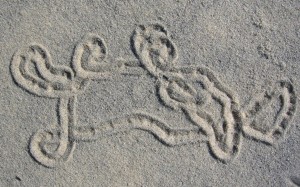Have you ever walked along a Georgia beach and noticed the broken shell of a clam lying on the sand, its owner still barely alive, and with no tracks or other signs near its body? How did it get there, and what could have caused this clam to end up like this? How could you find more clues to figure out what happened?
You take a few more steps along this beach, and you see tiny, pinpoint-like tracks on the beach in sets of four that form a V-shaped pattern. Some of these start at the surf and lead to small, circular holes in the coastal dunes. These holes have streaks of sand radiating outward, or pyramids formed by regularly sized and carefully stacked balls of sand. Would you be surprised to know that the same animal makes all of these traces? What animal was it, and what was it doing?
Near these holes, you also spot a meandering, looping squiggle in a dune, looking as if a child dragged her finger through the sand, yet with no footprints around it. Your eyes and mind now properly tuned, you see many more of these marks, along with shallow tunnels, some less than the width of a pencil but others much larger, looking like buried pipes. These disturb the otherwise smooth surfaces of the dunes, as do many animal tracks of various shapes, forming distinctive patterns. What made these traces and what do they tell us about unseen life under and on the dunes?
A hike in the forest of that same island reveals more mysteries: tracks of many sizes and forms, criss-crossing trails, dig marks, holes in tree trunks, piles of feathers, small tunnels and shafts, and other such oddities, with nary an animal in sight. With your senses attuned to your surrounding, all of these are noticeable during less than 15 minutes of slow walking. Applying this newly found awareness, you then look at the mudflats of a nearby salt marsh. It likewise holds many holes, miniature turrets, scratch marks, tracks, droppings, and trails. Who made these traces, what do they mean, and how do scientists study them?
Welcome to ichnology, the study of modern and fossil traces made by plants and animals in their daily lives, a science that opens your eyes and mind to a world of unseen behavior. My upcoming book, Life Traces of the Georgia Coast (Indiana University Press) looks at the ichnology of a specific place – the Georgia barrier islands – and its themes will be explored further through this blog.
Each chapter in the book begins with a story about traces on a Georgia barrier island, followed by tips about how to interpret these, especially how they relate to behavior. But Life Traces of the Georgia Coast also tells readers how paleontologists diagnose similar behaviors of the ancient past through their study of trace fossils, which are fossilized tracks, trails, burrows, nests, and other traces. Making this connection between the present and the past is an example of a basic principle of geology, called uniformitarianism, or, if you prefer using fewer syllables, actualism. The main theme of the book, then, is to show how the study of one place (the Georgia barrier islands) is filled with a wide variety of ecosystems, plants, and animals, which through their traces can provide a window into our interpreting the past.
Life Traces of the Georgia Coast is filled with lots of my enthusiasm and humor, which I hope is appreciated. But I generously illustrated it with my original artwork and photographs, so if you ever get bored reading it, you can always look at the pictures. I hope to do the same with this blog, teaching through my observations of natural phenomena on the Georgia barrier islands – usually conveyed through photographs and descriptions – and asking questions about what can be observed and from the everyday traces made on those islands. And because more than a million people visit the Georgia coast every year, there’s a good chance you may be one of those people, and that you will see traces that catch your attention, pique your curiosity, and ignite your sense of wonder. Get ready to explore, discover, and learn.

